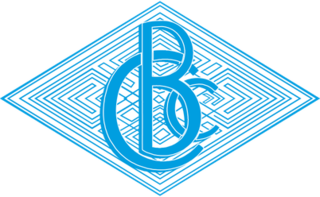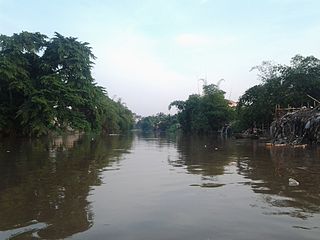Kimwenza | |
|---|---|
| Coordinates: 4°27′32″S15°17′19″E / 4.45889°S 15.28861°E |
Kimwenza is a neighborhood in the Democratic Republic of the Congo in the Mont Ngafula commune in the south of the capital, Kinshasa.
Kimwenza | |
|---|---|
| Coordinates: 4°27′32″S15°17′19″E / 4.45889°S 15.28861°E |
Kimwenza is a neighborhood in the Democratic Republic of the Congo in the Mont Ngafula commune in the south of the capital, Kinshasa.
Kimwenza is on a plateau above the main city of Kinshasa. [1] It is near to the Petites Chutes de la Lukaya. [2] It is a station on the Matadi–Kinshasa Railway, built between 1890 and 1898 to connect Matadi with Kinshasa, bypassing the unnavigable Livingstone Falls. [3]
In June 1893, Jesuits settled on the Ndjili River in what is now Masina. They were the first Catholic missionaries in the area. Within a month they moved away from the unhealthy, swampy conditions that they found, to Kimwenza. [2] The Saint Mary's mission, founded in July 1893, included a school to train African boys destined for the army or the priesthood. [4] The Jesuits felt it was essential for nuns to come and work with the local women and children, believing that Christianity would only take root if the women of the family were believers. [5] The Sisters of Our Lady of Namur set up a school there, in 1894. [6]
By 1900, the Jesuit priests were educating 100 boys, and the nuns had 169 girls. [7] While the priests always saw one of their goals as being to educate trainee priests, the sisters were at first only concerned with teaching Christianity to future wives and mothers. In the early 1920s, local women also began to ask to join the sisters. [8] The mission was the origin for numerous religious houses and schools. The Lycée de Kimwenza is now one of the best regarded schools of the city. [4] The Soeurs Clarisses had a convent at Kimwenza. During the troubles of 1996, it was ransacked by Rwandan soldiers. [1]
In October 1951 the Kisantu University was moved to Kimwenza. [4] The new location had the advantage of being closer to Leopoldville. However, a site further north about 300 hectares (740 acres) in size on the crest called Mont Amba had the advantage of being even closer to the city, and in April 1952 the governor general Eugène Jungers ceded ownership of the site to the university. [9] In July 1954 the university was placed under the direction of the Jesuits of the Catholic University of Louvain, and named Lovanium University. [10] While the Jesuits aimed to educate an African elite, the Belgian colonial administration was hostile to this goal, and it was only in 1956 that they recognized the university. [11] After independence it was to become the University of Kinshasa.
Since 2002, the Lola ya Bonobo sanctuary, founded by Claudine André, has been located just south of Kimwenza at the Petites Chutes de la Lukaya. Bonobos are an endangered species which only exist in the Democratic Republic of Congo in the wild. They are the great ape most closely related to humans, and even more intelligent than chimpanzees.
Lola ya Bonobo means 'paradise for bonobos' in Lingala, the main language of Kinshasa. In 2012, Lola ya Bonobo was home to 60 bonobos who live in 30 hectares of primary forest.
Typically, bonobos arrive as young infants. The bushmeat trade in Congo sees hundreds of bonobos killed each year for meat and the infants are sold as pets. When confiscated, these infant bonobos are taken to Lola ya Bonobo. They begin life at the sanctuary with close care from a substitute human mother, but are usually quickly ready to be integrated into a peer group, and shortly afterwards into one of the large mixed-age social groups.

Kinshasa, formerly named Léopoldville until 30 June 1966, is the capital and largest city of the Democratic Republic of the Congo. Once a site of fishing and trading villages along the Congo River, Kinshasa is now one of the world's fastest-growing megacities. Kinshasa's 2024 population was estimated at 17,032,322. It is the most densely populated city in the DRC, the most populous city in Africa, the world's fourth-most-populous capital city, Africa's third-largest metropolitan area, and the leading economic, political, and cultural center of the DRC. Kinshasa houses several industries, including manufacturing, telecommunications, banking, and entertainment. The city also hosts some of DRC's significant institutional buildings, such as the Palais du Peuple, Palais de la Nation, Court of Cassation, Constitutional Court, Cité de l'Union Africaine, Palais de Marbre, Stade des Martyrs, Immeuble du Gouvernement, Kinshasa Financial Center, and multiple federal departments and agencies.

Kongo Central, formerly Bas-Congo, is one of the 26 provinces of the Democratic Republic of the Congo. Its capital is Matadi.

Kongo or Kikongo is one of the Bantu languages spoken by the Kongo people living in the Democratic Republic of the Congo (DRC), the Republic of the Congo, Gabon, and Angola. It is a tonal language. The vast majority of present-day speakers live in Africa. There are roughly seven million native speakers of Kongo in the above-named countries. An estimated five million more speakers use it as a second language.

Mont Ngafula, or Mont-Ngafula, is a commune in the Lukunga District of Kinshasa, in the western part of the Democratic Republic of the Congo. By its surface area, Mont Ngafula is the third-largest commune in Kinshasa's city-province. It is located in the hilly southern area of Kinshasa and is intersected by the Lukaya River valley in its southern portion. The boundary with the Ngaliema commune is defined by the Lukunga River. Mont Ngafula shares borders with the Makala commune to the north, the Kongo Central Province to the south, the Lemba and Kisenso communes to the east, and the Selembao commune to the west. It has an estimated population of 718,197 (2015).

Ngaliema is a municipality (commune) in the Lukunga District of Kinshasa, the capital city of the Democratic Republic of the Congo.
Kituba is a widely used lingua franca in Central Africa. It is a creole language based on Kikongo, a Bantu language. It is a national language in Republic of the Congo and Democratic Republic of the Congo.

The University of Kinshasa, colloquially known as UNIKIN, is a public university located in Kinshasa's Lemba commune within the western region of the Democratic Republic of the Congo. It is the country's premier university. Initially established in 1954 as Lovanium University during Belgian colonial rule, the current university was established following the division of the National University of Zaire (UNAZA) in 1981.

The Central Bank of the Congo is the central bank of the Democratic Republic of the Congo. The bank's main offices are on Boulevard Colonel Tshatshi in La Gombe in Kinshasa.

Lola ya Bonobo is the world's only sanctuary for orphaned bonobos. Originally founded by Claudine André in 1994, since 2002 the sanctuary has been located just south of the suburb of Kimwenza at the Petites Chutes de la Lukaya, Kinshasa, in the Democratic Republic of the Congo.
Revue Mfumu'eto is a comic magazine series first published in 1990 at Kinshasa, Democratic Republic of Congo (DRC) by Jaspe-Saphir Nkou-Ntoula under the pseudonym Papa Mfumu'Eto 1er, which he adopted as his brand along with many variations. He led a small creative team to publish a variety of extremely popular comic books in Kinshasa from 1989 to 2005. This series and others were written in urban Lingala and produced on inexpensive paper in the language of his neighborhood, explicitly to make it accessible to them. His comic books were self-produced using stencils, cut-and-paste (adhesive-taped) montages, photocopy machines, printed on lithographic presses, and distributed informally on the streets and in Kinshasa's open markets. The first story in the series, Nguma a meli mwasi na kati ya Kinshasa, seized readers’ attention in 1990 and was widely interpreted as a daring attack against the DRC's notorious dictator, Mobutu, bringing instant fame to the Revue and its creator.

The Lukaya is a river in the Democratic Republic of the Congo. Its source is located in the Crystal Mountains, from which it runs eastward through Bas-Congo, then runs into the banks of the Ndjili River. The rail line from Matadi to Kinshasa runs along the river valley for a time, passing to the south and then to the east of Kinshasa. At one point the river was the namesake of a district in the Congo Free State.

Claudine André, is a Belgian conservationist. She founded Lola ya bonobo in 1994, which is a bonobo sanctuary, just south of Kinshasa, at Mont Ngafula, in the Lukaya Valley, Democratic Republic of Congo.

The Ndjili River is a river that flows from the south through the capital city of Kinshasa in the Democratic Republic of the Congo, where it joins the Congo River. It separates the districts of Tshangu and Mont Amba. The river gives its name to the Ndjili commune and to the Ndjili International Airport.

The Petites Chutes de la Lukaya is a set of small waterfalls on the Lukaya River. They are just south of Kinshasa, the capital city of the Democratic Republic of the Congo. They are about 1 metre (3.3 ft) high.
The following is a timeline of the history of the city of Kinshasa, Democratic Republic of the Congo.

Marcel Antoine Lihau or Ebua Libana la Molengo Lihau was a Congolese jurist, law professor and politician who served as the inaugural First President of the Supreme Court of Justice of the Congo from 1968 until 1975, and was involved in the creation of two constitutions for the Democratic Republic of the Congo.
Isidore Ndaywel è Nziem, is a Congolese historian and linguist. He is the author of several essays, studies and other publications about the history of the Congo, including the overview work L'histoire générale du Congo: De l'héritage ancien à la République démocratique.
Jaspe-Saphir Nkou-Ntoula was born in 1963 at Matadi, Democratic Republic of Congo (DRC) is best known by his pseudonym, Papa Mfumu'Eto 1er, which he adopted as a personal brand as a comic book creator in Kinshasa. He studied painting and interior design at the Académie des Beaux-Arts (Kinshasa) before in 1989 leading a small creative team, called Mpangala, in producing a variety of extremely popular, handmade and self-published comic books in Kinshasa. He is best known for the Revue Mfumu'eto which, like most of his work, is written in urban Lingala.

The Gare de l'Est, also known as Kinshasa Est or Kinshasa Central Station, is a central railway station situated in the Gombe commune of Kinshasa, Democratic Republic of the Congo (DRC). Positioned along the Matadi–Kinshasa Railway line, it functions as a pivotal transshipment point connecting the railway and the river. Managed by the Société Commerciale des Transports et des Ports (SCTP), the station stands near Ngobila Beach at the Port of Kinshasa, fostering maritime links with Brazzaville, and is conveniently located close to SCTP buildings and the Ministry of Transport and Channels of Communication.

The Sainte Marie de Kimwenza is a Roman Catholic parish church located in the Mont Ngafula commune of the Lukunga District in Kinshasa within the western region of the Democratic Republic of the Congo (DRC). Established in 1954, the mission was initially founded by the Jesuits in 1893, and in 1894, the Sisters of Notre Dame de Namur established a girls' school. The Faculty of Agronomic and Veterinary Science has obtained all necessary official authorizations for its operation, including the acquisition of land opposite the church after a long discernment process.